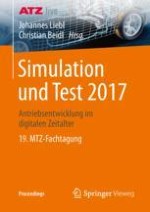2018 | OriginalPaper | Buchkapitel
Aeroacoustics Simulation for Pulsated Exhaust Flow
verfasst von : Cyril Triplet, Nicolas Driot
Erschienen in: Simulation und Test 2017
Verlag: Springer Fachmedien Wiesbaden
Aktivieren Sie unsere intelligente Suche, um passende Fachinhalte oder Patente zu finden.
Wählen Sie Textabschnitte aus um mit Künstlicher Intelligenz passenden Patente zu finden. powered by
Markieren Sie Textabschnitte, um KI-gestützt weitere passende Inhalte zu finden. powered by
Exhaust systems need to increase their after treatment efficiency in order to meet the future emissions regulations. This involves complex systems containing multiple catalysts and a filter, which damp the engine order pulsations. Consequently, the flow-induced noise is increasing its contribution to the emitted sound. These noise sources are based on multiple physics phenomena, and therefore require new measurement methods and complex flow simulation with acoustic propagation: the CAA (Computational Aeroacoustics). Currently the Mach number or similar analogies are commonly used in industry with defined targets in order to prevent flow noise issues. Even if this easy simulation process helps to find the best geometry among others, it is not accurate enough and does not permit a good understanding of the noise sources. The DNS (Direct Numerical Simulation) is a CAA approach based on a compressible and transient calculation of Navier-Stokes equations that can directly model the pressure fluctuation and therefore predict the SPL (Sound Pressure Level) and its spectrum. It requires high computational resources, which are today available thanks to faster and cheaper processors along with optimized CFD algorithms.The aim of this study is to predict the flow noise emitted by a perforated plate under a pulsed flow condition. The input data and boundary conditions of the system are key factors to get reliable results. As it is difficult to provide temperature fields out of measurements and in order to avoid inaccuracies, an innovative measurement method is developed to measure cold pulsating flow.As a first step, a steady state flow case analysis is conducted on a normal flow bench to calibrate the CAA simulation. The Large Eddy simulation using the CFD software Starccm+ is correlated with the measurement data and show a good match. After that, a new test bench is developed using an IC engine w/o combustion to generate cold pulsating flow. Two sensor devices are placed before the plate. The first one, based on a Venturi system, measures the real time mass flow and the second one the static pressure. Because the measured mass flow data was not consistent, the pressure data is used as an input for the boundary condition in the CAA simulation. The pulsed calculation shows promising results as the frequencies are captured very well with acceptable SPL accuracy.
